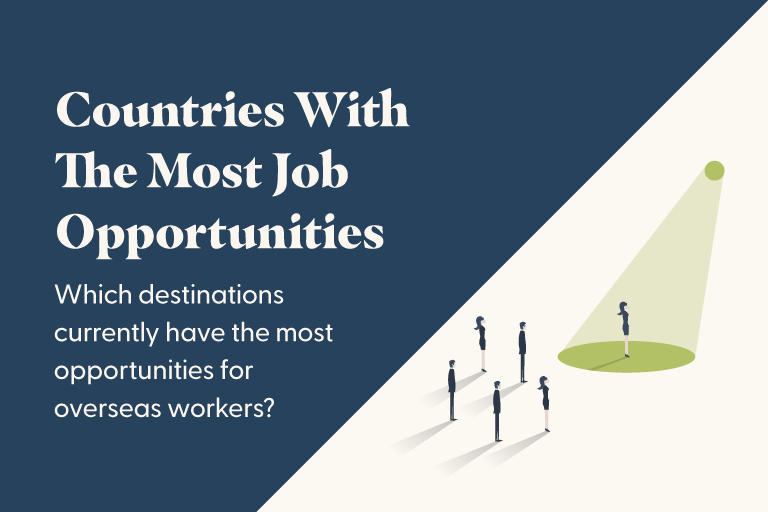Recent figures from the Migration Data Portal indicate that the number of international migrant workers is more than 167 million1. With around a quarter of Gen Z and Millennials expressing a desire to live and work abroad, the demand for international careers is only set to rise.
To understand the current global job market, we have examined factors such as employment rate, the number of Google searches related to working in that country, and labour shortages. This report covers everything job hunters need to know, from exploring countries with the most job opportunities to identifying which sectors are struggling for staff.
Ranked: The countries with the best job opportunities
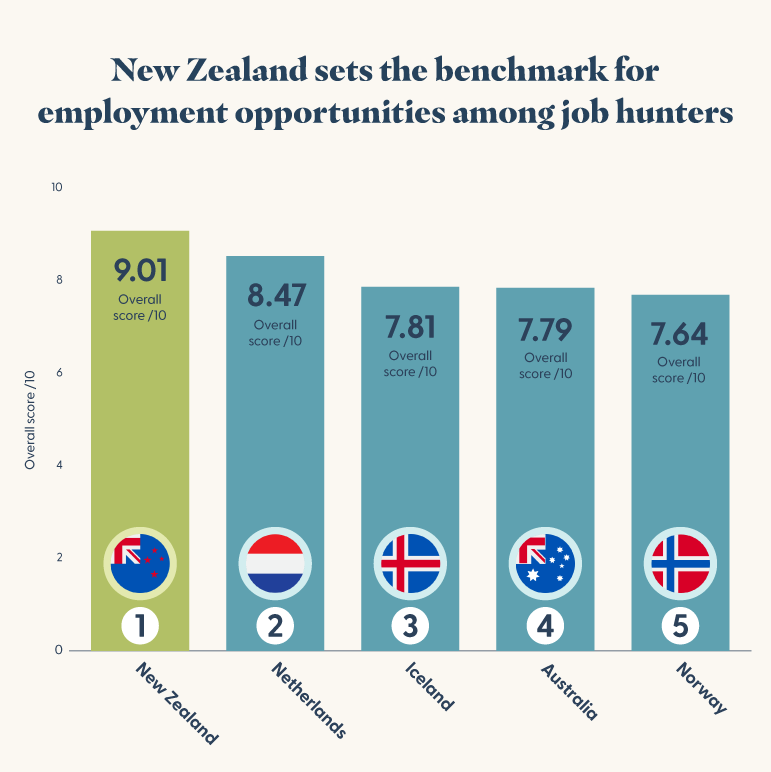
To rank nations in our study, we have compared country-wide data from the following factors important to job hunters (any unavailable data is marked ‘N/A’):
- Full-time and part-time employment rate: The higher the percentage, the stronger/ more stable the job market is seen to be.
- Workforce activity rate: The higher the percentage of people working or actively looking for a job, the healthier the country’s job market and economic stability.
- Gender wage gap: The lower the gap between men’s and women’s pay, the more inclusive the country’s job roles are.
- Post-higher-education employment rate: The higher the percentage of employed people who have completed secondary education, the greater the demand for those with such qualifications.
After normalising the data and providing each country with a score out of 10, here’s what we found.
| Rank | Country | Full-Time Employment Rate | Part-Time Employment Rate | Workforce activity rate | Gender Wage Gap (Unadjusted) | Post Higher-Education Employment Rate | Overall Score /10 |
|---|---|---|---|---|---|---|---|
| 1 | New Zealand | 68.0% | 19.5% | 72.1% | 4.2% | #N/A | 9.01 |
| 2 | Netherlands | 66.2% | 35.2% | 68.5% | 6.1% | 89.9% | 8.47 |
| 3 | Iceland | 73.5% | 16.5% | 80.5% | 10.2% | 90.6% | 7.81 |
| 4 | Australia | 64.2% | 23.5% | 66.9% | 11.3% | #N/A | 7.79 |
| 5 | Norway | 62.9% | 20.5% | 65.7% | 4.5% | 89.1% | 7.64 |
| 6 | Switzerland | 64.6% | 25.2% | 67.7% | 12.1% | 89.5% | 7.46 |
| 7 | Sweden | 61.7% | 11.7% | 75.2% | 7.4% | 90.5% | 7.01 |
| 8 | Malta | #N/A | 22.8% | 65.6% | #N/A | 91.7% | 6.75 |
| 9 | Denmark | 61.2% | 18.1% | 63.5% | 5.8% | 88.7% | 6.65 |
| 10 | Ireland | 63.0% | 20.3% | 65.1% | 11.8% | 87.9% | 6.29 |
1. New Zealand – Overall score of 9.01 /10
Scoring 9.01, New Zealand has the highest overall score for job opportunities. This Oceanic island country has demonstrated its proactiveness regarding fairness and equality, boasting one of the lowest gender wage gaps through initiatives like MindTheGap. Aside from this, almost three-quarters of people here are working or actively looking for a job according to OECD data, indicating an engaged and active economy.
New Zealand is one of the most welcoming countries to migrants, offering Skilled Migrant Category Resident Visas to almost anyone with a job offer from an accredited New Zealand employer.
2. Netherlands – Overall score of 8.47 /10
The Netherlands’ job market is healthy, whether you’re looking for a full-time or part-time position. With more than two-thirds of the population currently in full-time employment, according to data from the OECD, this country is attractive for job-seekers in terms of more potential for career development and greater job security. This, paired with a strong post-higher-education employment rate (89.9%), is just one of the factors contributing to this country’s 8.47 overall score.
As part of the European Union, the Netherlands offer non-EU citizens a simple-to-complete three-year renewable Blue Card if they can prove they have higher professional qualifications or at least five years of experience in their chosen field.
3. Iceland – Overall score of 7.81 /10
Iceland completes this ranking with an overall score of 7.81. Despite having a lower population than most, Iceland’s job market has many appealing factors for migrants. This country is an excellent fit for those with higher education qualifications, as more than 90% of post-education Icelandic residents are employed. Moreover, this country has the highest full-time employment rate of any location on this list, totalling 73.5% according to the latest data from the OECD. It’s not just jobs, as our 2025 Immigration Index revealed that Iceland is the best overall country for migrants to relocate to.
If you are interested in moving here, Iceland offers a range of work visas, no matter what type of work you want to be employed for. Some Iceland visa options include a ‘Temporary Work Permit for a Job that Requires Expert Knowledge’ and a ‘Temporary Work Permit for Labour Shortages’.
Iceland tops our study with the highest employment rate
 A high employment rate usually indicates improved working conditions, career development opportunities, and openness to migrant workers, with locals less concerned about job scarcity. Of all the countries on this list, Iceland has the highest employment rate, with almost three-quarters of residents working here.
A high employment rate usually indicates improved working conditions, career development opportunities, and openness to migrant workers, with locals less concerned about job scarcity. Of all the countries on this list, Iceland has the highest employment rate, with almost three-quarters of residents working here.
The Netherlands offers the best part-time employment rate

The opportunity to undergo part-time employment when first moving to a new country can be a great stepping stone into the job market. Aside from this, a high part-time employment rate indicates how accommodating a country is to work-life balance, which is essential for migrants who may have young families. With this in mind, the Netherlands has a higher part-time employment rate than any other country (35.2%).
Iceland has the most people working or actively looking
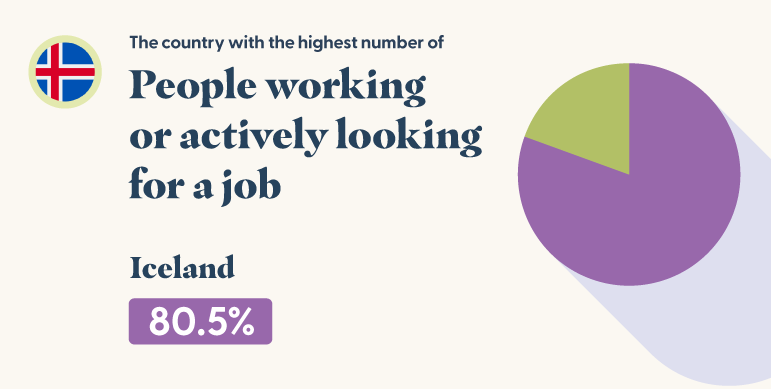
Iceland has a significant number of people working or actively looking for a job (80.5%), which may not sound good from the viewpoint of a job seeker; however, this is certainly not the case. A high workforce activity rate is an excellent sign for migrants, especially skilled job seekers, as these countries are often correlated with more inclusive employers, economic confidence, and strong demand for talent.
Belgium has the lowest gender pay gap 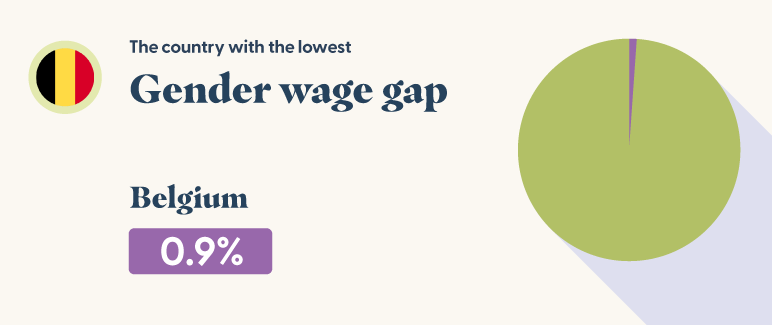
Ideally, the job market would be inclusive and diverse, with pay based on a person’s skills and experience rather than their background. Unfortunately, most countries are still fighting to achieve equal opportunities. However, regarding the gender wage gap, Belgium has the smallest difference between men’s and women’s earnings of the countries we analysed.
Hungary has the best employment rate for graduates 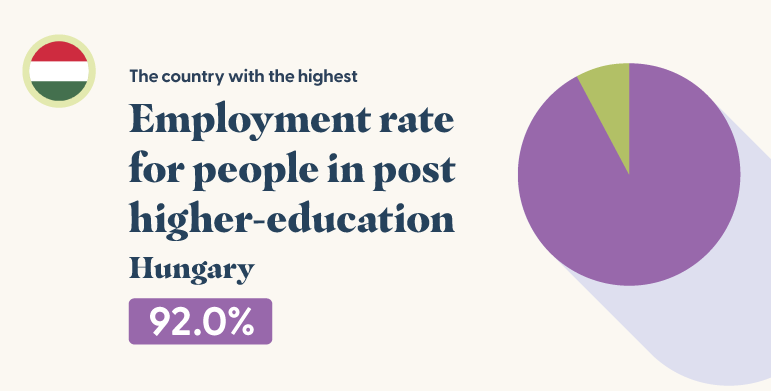
Those who have had the opportunity to complete education at a degree level or higher don’t want their qualifications to go to waste. Compared to its population, Hungary has employed more people proportionally in post-higher education than any other country on this list, indicating that those with a degree in their toolkit could thrive here.
Luxembourg emerges as the top career destination in global searches
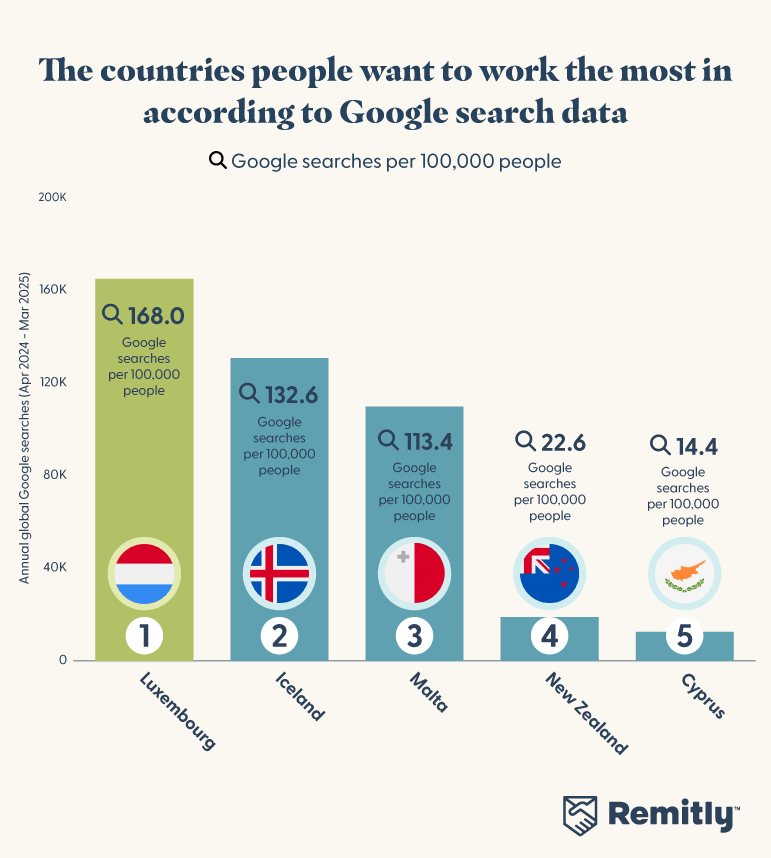
The internet is often the first place we go when we want to know more about a topic, and job opportunities are no exception. The following ranking reveals which locations have the most searches for phrases related to working in that country.
| Annual Global Google Searches (Apr 2024 – Mar 2025) | |||||
|---|---|---|---|---|---|
| Rank | Country | jobs in [country] | work visa for [country] | work permit in [country] | Total |
| 1 | United Kingdom | 472,800 | 940,500 | 940,500 | 2,353,800 |
| 2 | Luxembourg | 808,500 | 469,100 | 469,100 | 1,746,700 |
| 3 | Australia | 449,000 | 495,000 | 495,000 | 1,439,000 |
| 4 | Canada | 658,100 | 364,800 | 364,800 | 1,387,700 |
| 5 | New Zealand | 301,500 | 379,800 | 379,800 | 1,061,100 |
| 6 | United States | 283,800 | 524,000 | 136,400 | 944,200 |
| 7 | Germany | 366,200 | 283,800 | 283,800 | 933,800 |
| 8 | Malta | 522,000 | 71,300 | 71,300 | 664,600 |
| 9 | Japan | 286,800 | 158,700 | 158,700 | 604,200 |
| 10 | Iceland | 509,200 | 23,100 | 23,100 | 555,400 |
1. United Kingdom – 2,353,800 job-related Google searches
More than 2.3 million global Google searches have been made for ‘jobs in the UK’ and similar queries. When broken down by keyword, almost a million queries for ‘work permit in the UK’ have been processed in the last year alone. If you are one of those interested in moving here for work, the UK offers a skilled work visa if you meet their criteria.
2. Luxembourg – 1,746,700 job-related Google searches
In the last year alone, more than 1.7 million Google searches have been made surrounding job opportunities in Luxembourg, making it the second most searched country for migrant workers. As part of the EU, highly skilled job seekers looking to relocate to Luxembourg can apply for a Blue Card valid for up to five years.
3. Australia – 1,439,000 job-related Google searches
Australia has the third-highest number of job-related searches of all the countries on this list, with more than 1.4 million searches in the last year. The easiest work visa to obtain in Australia is the ‘new skilled worker visa’, which helps to fill jobs for both migrants and the local economy.
Although the U.S. has the highest number of immigrants of any country, searches were lower than many other nations. This may be due to the fact that people search specifically for ‘jobs in’ a certain state or city, rather than the country as a whole, due to its large size.
What are the hardest jobs to fill around the world right now?
Have you ever wondered which areas of the world most need international talent? We used Cedefop’s Labour and Skills Shortage Index (CLSSI) dataset to uncover the occupations with the biggest labour shortages in European countries. We then paired this with similar findings from the Manpower Group, Ministry of Labour reports, and official government statistics.
| Rank | Occupation | Countries experiencing this as their biggest labour shortage |
|---|---|---|
| 1 | Refuse workers and other elementary workers | 11 |
| 2 | Legal, social and cultural professionals | 6 |
| 2 | Drivers and mobile plant operators | 6 |
| 4 | Labourers in mining, construction, manufacturing and transport | 5 |
| 4 | Assemblers | 5 |
| 6 | Agricultural, forestry and fishery labourers | 4 |
| 6 | Legal, social, cultural and related associate professionals | 4 |
| 6 | Health professionals | 4 |
| 9 | Food preparation assistants | 3 |
| 9 | Cleaners and helpers | 3 |
| 9 | Street and related sales and service workers | 3 |
| 9 | Food processing, wood working, garment and other craft and related trades | 3 |
| 9 | Administrative and commercial managers | 3 |
| 9 | Science and engineering professionals | 3 |
| 9 | Manufacturing | 3 |
High-skilled non-manual occupations
Of all occupations under the bracket of high-skilled and non-manual, those within the legal, social, and cultural professions are most in demand across the European Union. When broken down by country, Belgium, Sweden, Spain, and Luxembourg are the countries where this occupation is the most highly sought-after.
Hungary is experiencing shortages across a range of highly skilled non-manual professions, with a need for staff in science and engineering, teaching, and healthcare sectors, among others. TEFL teachers, a popular high-skilled non-manual occupation, could earn an average of 225,000 to 330,000 HUF (£473 to £694) per month2.
Skilled non-manual occupations
Personal care workers, such as disability support workers and nursing assistants, are crucial in caring for others’ health. Unfortunately, according to recent data, Portugal and Belgium face considerable labour shortages in this sector.
There are also shortages of personal service workers, including hairdressers and house cleaners in Spain and Belgium. For individuals interested in relocating to Spain and working as a hairdresser, they can expect to earn a salary of approximately €24,748 (£21,017)3.
Skilled manual occupations
If you are skilled in building and related trades and are considering the migrant worker life, Latvia and Spain have plenty of business opportunities for you—both countries are experiencing a supply and demand imbalance in this regard.
Aside from the building trade sector, assemblers are another highly sought-after occupation, with countries all over the EU crying out for staff to assemble components and create finished products. Estonia, Finland, and Greece are just some of the countries that need staff in the assembly sector.
For a job like this, there is an average yearly salary of €12,575 (£10,683) for a production assembler in Estonia4, €40,681 (£34,560) for an assembler fabricator in Finland5, and €20,143 (£17,112) as part of an assembler team in Greece6.
Elementary occupations
Essential roles like waste disposal staff and other manual labour jobs often face harsh working conditions and lower wages, but there are many countries facing a shortage of workers in this field. Sweden, Spain, and Slovenia all report shortages in these fields.
As is expected, pay differs across borders. The average earnings for a recycling worker in Sweden are 32,100 SEK (£2,491) per month7 while 80% of refuse collectors in Slovenia earn between €1,278 (£1,086) and €1,987 (£1,688)8.
Methodology
All data is accurate as of April 2025.
Our initial seeding list comprised all countries under at least one of the following categories: EU country, OECD country, or ranking 0.8 or higher on the Human Development Index.
We used OECD Data Explorer to find each country’s most recent employment rate, workforce activity rate, unadjusted gender wage gap, tertiary education employment rate, and part-time employment rate. Any countries with more than two data points missing were excluded.
We used job-related factors (employment and part-time employment rate, workforce activity rate, gender wage gap, and post-higher-education employment rate). We normalised each factor out of 10 before taking an average, giving each country an overall score out of 10.
We used Google Ads Keyword Planner to find the total number of Google searches for the terms ‘jobs in [country]’, ‘work visa for [country]’, and ‘work permit in [country]’ between April 2024 and March 2025.
We used various sources such as Cedefop Labour and Skills Shortage Index, ManpowerGroup, and official government statistics to determine which occupations have the biggest labour shortages for each country.
Additional sources
2 https://www.internationalteflacademy.com/blog/how-much-do-english-teachers-make-in-hungary
3 https://www.erieri.com/salary/job/hairdresser/spain
4 https://www.salaryexpert.com/salary/job/production-assembler/estonia
5 https://www.erieri.com/salary/job/assembler-fabricator/finland
6 https://www.salaryexpert.com/salary/job/assembler-team/greece
7 https://statsskuld.se/en/lonestatistik/atervinningsarbetare
8 https://www.boljsaplaca.si/en/salaryinfo/service-industries/refuse-collector
